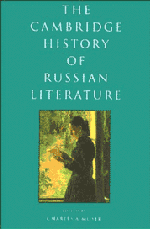Book contents
- Frontmatter
- 1 The literature of old Russia, 988–1730
- 2 The eighteenth century: neoclassicism and the Enlightenment, 1730–90
- 3 The transition to the modern age: sentimentalism and preromanticism, 1790–1820
- 4 The nineteenth century: romanticism, 1820–40
- 5 The nineteenth century: the natural school and its aftermath, 1840–55
- 6 The nineteenth century: the age of realism, 1855–80
- 7 The nineteenth century: between realism and modernism, 1880–95
- 8 Turn of a century: modernism, 1895–1925
- 9 The twentieth century: the era of socialist realism, 1925–53
- 10 The twentieth century: in search of new ways, 1953–80
- 11 Afterword: Russian literature in the 1980s
- Bibliography
3 - The transition to the modern age: sentimentalism and preromanticism, 1790–1820
Published online by Cambridge University Press: 28 March 2008
- Frontmatter
- 1 The literature of old Russia, 988–1730
- 2 The eighteenth century: neoclassicism and the Enlightenment, 1730–90
- 3 The transition to the modern age: sentimentalism and preromanticism, 1790–1820
- 4 The nineteenth century: romanticism, 1820–40
- 5 The nineteenth century: the natural school and its aftermath, 1840–55
- 6 The nineteenth century: the age of realism, 1855–80
- 7 The nineteenth century: between realism and modernism, 1880–95
- 8 Turn of a century: modernism, 1895–1925
- 9 The twentieth century: the era of socialist realism, 1925–53
- 10 The twentieth century: in search of new ways, 1953–80
- 11 Afterword: Russian literature in the 1980s
- Bibliography
Summary
From 1790 to 1820 the Russian Empire underwent tumultuous years beginning with the immediate aftermath of the French revolution, continuing through the rise of Napoleon and the Napoleonic wars which saw the French invasion of Russia in 1812 and the allied occupation of Paris, and ending with the intellectual ferment of the movement which would culminate in the abortive Decembrist uprising of 1825. No great fraction of the nation’s energies at this time could be directed toward literature.
In literary terms this period begins with a work which faithfully reflects the political tensions of the time of the French revolution – Radishchev’s Journey from St. Petersburg to Moscow – and ends with a narrative poem, Pushkin’s Ruslan and Lyudmila, which expresses well the romantic sensibility then on the verge of a short-lived cultural triumph. In the intervening thirty years, a culturally chaotic period, a major alteration occurred in literature’s approach to the world. As Arthur Lovejoy has so aptly put it, during the years of neoclassicism and the Enlightenment intellectuals looked to a single standard, “conceived as universal, uncomplicated, immutable, uniform for every rational being.” But then a “momentous” shift in outlook occurred, and was completed by the time of the romantic period, “when it came to be believed not only that in many, or in all, phases of human life there are diverse excellences, but that diversity itself is of the essence of excellence.” In short, the change in emphasis was from a unitary human standard to a belief in diversity for its own sake.
- Type
- Chapter
- Information
- The Cambridge History of Russian Literature , pp. 92 - 135Publisher: Cambridge University PressPrint publication year: 1992



